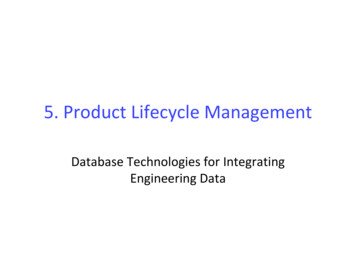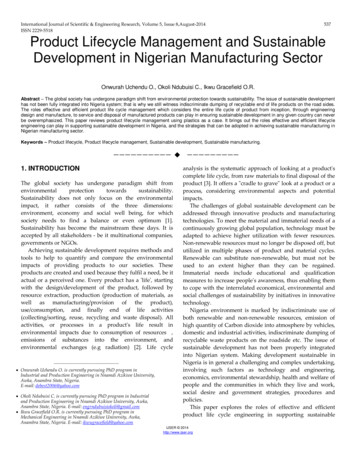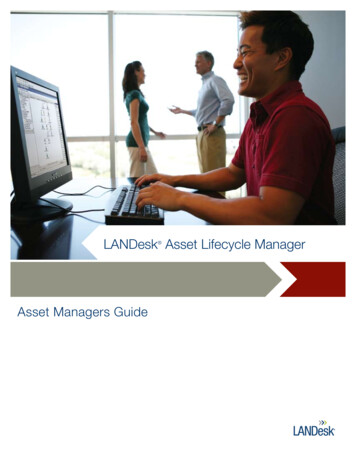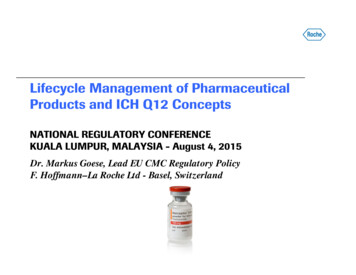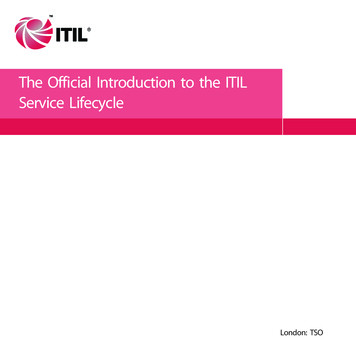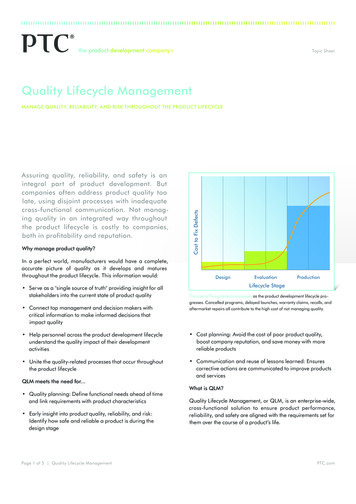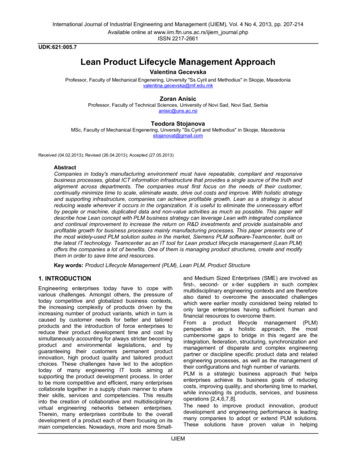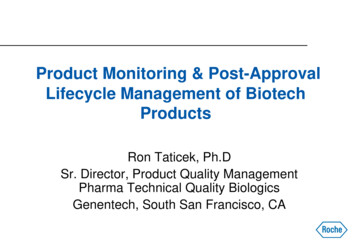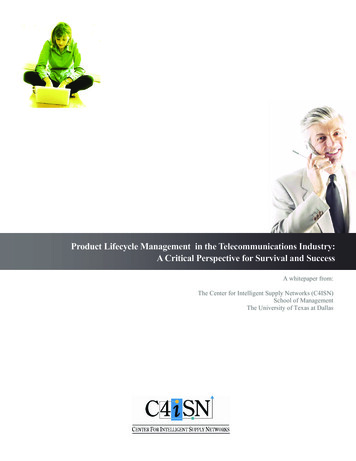
Transcription
Product Lifecycle Management in the Telecommunications Industry:A Critical Perspective for Survival and SuccessA whitepaper from:The Center for Intelligent Supply Networks (C4ISN)School of ManagementThe University of Texas at Dallas
AcknowledgementsThe authors would like to thank the following:Siemens for underwriting the development of this whitepaper and assistance inthe research process by providing access to their customers.Divakar Rajamani, Ph.D., Managing Director C4ISNSree Hameed, Executive-in-Residence, C4ISNAbout Siemens UGS PLM SoftwareUGS PLM Software, a division a Siemens Automation and Drives (A&D), is aleading global provider of product lifecycle management (PLM) software andservices with 4.4 million licensed seats and 47,000 customers worldwide. Headquartered in Plano, Texas, UGS PLM Software’s open enterprise solutions enablea world where organizations and their partners collaborate through global innovation networks to deliver world-class products and services. For more informationon UGS PLM Software products and services, visit www.siemens.com/ugs.Siemens and the Siemens logo are registered trademarks of Siemens AG.UGS is a registered trademark of UGS Corp. 2007 UGS Corp. All rights reserved.
What is this whitepaper about? And how is it organized?Executive SummaryEnd-usertrendsSupply chaintrendsProduct lifecycle considera-Figure 1: PLM in Telecom is amultidimensional challengeIntroductionWith worldwide revenues exceeding 1.2 trillion dollars annually, the Telecomindustry is one of the largest, serving the needs of an increasingly global and interconnected world. It is also one of the more complex industries due to the following characteristics: Multiple products and levels: The product, in the eyes of end-users, is becoming an “experience” that is based on the delivery of voice, video, anddata as an integrated package across mobile and fixed infrastructure —which, deconstructed reveals multiple layers of hardware, software, and services. Rapid technology innovation (and obsolescence): While convergence createsnew opportunities for growth through innovation, competition is intense ascompanies race to gain first-mover advantage — which accelerates obsolescence at all levels. Fragmented supply chains: Far from the days of the vertically-integratedmonopoly of the past, today’s typical Telecom supply chain is a highly fragmented global operation where multiple enterprises (and supply chains) mustcollaborate to design, develop, and deliver a coordinated experience.Taken together, these characteristics underscore the fact that Product LifecycleManagement (PLM) in Telecom is a multi-dimensional topic (as shown in Figure1). The intent of this paper is to explore these dimensions and help the readergain a broad perspective of PLM in the Telecom industry. In order to help“connect the dots” and present the “big picture”, this paper is organized as aseries of focused questions, which are summarized below:(I) What’s happening in terms of end-user trends? How are customer expectations changing? Why is innovation getting a lot of attention these days? How can PLM address the CEO’s priority to innovate?(II) What are the key supply chain trends? How has the Telecom industry chain landscape evolved? What is the supply chain structure that has emerged? What are the risks of not thinking through the lifecycle?(III) What are the key PLM considerations for Telecom? Why is Product Lifecycle Management critical to Telecom? How do the Telecom players make money? Why is collaboration critical, especially in a globally distributed operation? Why is risk management becoming more important? What are the emerging growth areas in Telecom? What are the key PLM technology enablers for Telecom? Why should Telecom companies make PLM their priority?
How are customer expectations changing?In the past, the Telecom industry was dominated by large, vertically integratedmonopolies who dictated the terms of service (in a single category like voice ordata over wireline, cable, etc.) to their customers. The objective of this networkcentric business model was simple: maximize the profitability of large infrastructure investments by extending their lifecycles as long as possible. But since deregulation in 1984 (in the U.S.), the customer has been steadily moving towardsthe center of this universe as shown below in Figure 2:End-user ftwareNetworkDeviceFigure 2: The shift towards a customer-centric universeCompetition is the driving force.The asset-intensive nature of the service providers makes it challenging to betruly customer-centric in the Telecom business. Customer loyalty has been crucial to success in a business model that traditionally assumed a lifecycle of 10-15years for its infrastructure investments. But rapid technology advances are undermining that model as service providers are under constant pressure to upgradetheir infrastructure at significant cost — or risk losing market share.Customers want to buy an experience.Customer expectations have also changed along with the advances in technology.What used to be a utility device for voice communications is now increasinglybecoming a multi-media entertainment device, forcing the service provider to becapable of delivering a bundled set of services — such as the triple-play offer ofvideo, VOIP, data — via a high-bandwidth network (e.g., fiber to the premises)that is focused on the end-user "experience" — a significant challenge that requires synchronizing multiple product lifecycles.Maximizing the end-user service lifecycle is the goal.Considering the fact that it costs 5 times as much to acquire a new customer thanto retain an existing one, it is the lifecycle of the service contract that’s the newfocus. Ultimately, it is this strategic realignment of multiple lifecycles of products, software, and services that is behind the many changes that we are seeing inthe Telecom industry today.
Why is innovation getting a lot of attention these days?Focus on innovationAccording to a recent survey of CEOs worldwide, innovation is now ranked the#1 business issue on their agenda1. The concern is not that companies aren’t innovating today. Rather, the focus is on the need to do more and faster as a meansto rapidly adapt in an increasingly dynamic business environment.After all, cutting costs through efficiency can only go so far. Today’s marketleaders clearly recognize that a strategy for increasing top-line revenue must haveinnovation at the core of its growth engine.Innovation is more than just new product development.Another study by Boston Consulting Group and BusinessWeek showed thatCEOs are thinking in much broader terms, and that their innovation mandate isn’tjust about new products2 (i.e., product innovation) but that it included two additional dimensions:Process Innovation: Innovation is also about redesigning the underlying businesspractices that help take these products to market profitably. A Telecom examplecould be the launch of a new service capability based on mobile RFID technology which requires the synchronization of multiple supply chains to ensure anintegrated customer experience.Business Model Innovation: Ultimately, innovation can also help re-evaluate thebusiness focus and the requisite core competencies. In Telecom, this is evident ascarriers who traditionally avoided contracts with extensive integration requirements are now actively pursuing these types of projects (and competing withtraditional systems integrators) to ensure their long-term survival.Innovation comes from employees, partners, and customers.Another important aspect of the study found that CEOs recognized that peoplewere at the core of any innovation initiative. They identified employees as themost significant source of innovation, followed by business partners and thencustomers. A relevant example is the Apple iPod: R&D initially wasn’t sure ofwhat it had, but once in the hands of customers, its application became evident —and the rest is history. The notion that innovation is no longer restricted to a select few inside the research labs of the organization — but actually being facilitated by the many on the outside — is very real to Telecom, given its ubiquitousnature.A lifecycle view helps understand the whole picture.Last but not least, the BCG-BusinessWeek survey discovered that almost half therespondents who identified innovation as a priority were disappointed in theirreturns on investment in that area. This is where Product Lifecycle Management(PLM) becomes an invaluable discipline because it represents the vital threadthat brings together the top three sources of innovation —employees, business partners, and customers — to successfully deliver on thegrowth and profitability objectives of the company and its supply chain partners.[1] Global CEO Study 2006: Expanding the Innovation Horizon, IBM[2] The World’s Most Innovative Companies: BusinessWeek, April 24, 2006
How can Product Lifecycle Management help address the CEO’s priority to innovate?Innovation and PLMPLM: Increase productinnovation & profitabilityProduct Lifecycle Management is growing in importance.PLM isn’t a new concept. Even before the term was coined, it was already a fundamental construct of any product-based business strategy. But it has capturedthe spotlight today because of its potential as a core discipline that can help address the innovation issue. With shrinking product lifecycles across the board,companies no longer have the luxury of assuming that “things will work out inthe long run.” When studies show that 80% of the total cost structure over a product’s lifecycle is pre-determined during the concept and design phase (Figure 3),a shorter lifecycle dramatically increases the risk of not recouping product investments.MAKEMOVESOURC 80% of a product’s total lifecycle costs aredetermined inCRE-STORESELLDISPOSESERSCM: Increase supplychain velocity & effi-PLM is everyone’s responsibility.Traditionally, we’ve thought of product innovation as the domain of engineering. As the vertically-integrated enterprise ofyesterday evolves towards a dispersed or virtual structurewhere many functions are being managed by business partners,the product lifecycle perspective becomes more important because it provides a holistic view across disparate enterprisesilos in order to provide a coordinated response to the endcustomer — who is ultimate driver of demand. Thus, PLMisn’t just for the enterprise that designs a product — it needs tobe embraced by every enterprise that supports it in the end-toend supply chain.PLM helps align multiple lifecycles for profitability.In Telecom, delivering a unified experience to the end-userrequires the synchronization of multiple lifecycles of consumerdevices, software applications, and network infrastructureacross a number of industry players. PLM provides the basisfor the “design chain” that shows the critical linkages that needto be managed over the lifecycle of the end-user experience.PLM drives SCM.Product Lifecycle Management and Supply Chain Management are highly inter-related disciplines and should not beFigure 3: PLM helps shape a product’s financial profileviewed independently (Figure 3). Because if we expect the ratewhile SCM helps to execute and adaptof new product introductions to increase in the future, theninevitably, the supply chain supporting it must also dynamically change. Taken together, the opportunities for innovation dramatically increase because PLM and SCM expand the scope of innovation from product toprocess and business model innovation — which ultimately helps drive top-linegrowth and reduce bottom-line expenses.
How has the Telecom industry landscape evolved?The evolution of the Telecom industry reveals drastic changes among the playersover the last two decades. Figure 4 depicts two contrasting scenarios:Industry evolutionCustomer-Solution Under the old network-centric model, the supply chain strategy follows a“push-based” model in which the supplier is more powerful than the customer. The supplier controls or “pushes” supply and has the luxury of putting efficiency ahead of customer responsiveness. In the emerging customer-centric or demand-driven model, the customer ismore powerful than the supplier as the customer effectively “pulls” the supply chain, and thus the supplier has to put responsiveness ahead of efficiency.FutureFor sake of brevity, we summarize the evolution (of the U.S. market) through aseries of snapshots to highlight key points relevant to the PLM discussion.ServiceNetworkcentric 1980s: Until its divestiture in 1984, AT&T played the combined role of service provider and technology OEM as shown on the left side of Figure 4.During this time, the product lifecycle was fully controlled by AT&T up todivestiture; the PLM perspective began to fragment as the strategies of theoperating companies and its manufacturing operations diverged in the late1980s. Early 90s: Wireless and cable growth takes off. Rapid advances in IP networking and wireless technologies shift power to the Network OEMs.Customers must still acquire phone, cable, wireless, and satellite servicesfrom different vendors, and competition is largely confined within thosesegments. Product lifecycles for wireline, wireless, and cable technologiesexist independent of each another. Late 90s: OEMs shift to global sourcing strategies to contain costs. Outsourcing accelerates and practically every network OEM transfers its production assets and processes to contract manufacturers. With the demise ofthe vertically integrated enterprise, the supply chain becomes fragmented. 2000s: A combination of factors — including overexpansion, fraud, complex regulation, and nonstop pricing pressures — come together to create anindustry meltdown. As the industry starts its recovery in 2004, the structuralchanges continue. Service providers focus on developing the right portfolioto support the convergence of voice, video on data across wireline, cable,and wireless through consolidation. Network OEMs and their suppliers faceregulatory pressures like WEEE (Waste of Electrical & Electronic Equipment) and RoHS (Restriction of Hazardous Substances), and licensing issueslike 3G. Increasing obsolescence and cost pressures driven by global competitors are affecting all players. In addition to supply chain fragmentation,there is also “design chain” fragmentation creating synchronization challenges across the portfolio of products and services demanded by the rovidersOEMsFigure 4: The power shift from the OEM to the Enduser means supply chains must be reconfigured to deliver customer-centric solutionsThis brief summary captures the backdrop against which the major supply chainplayers find themselves in today’s environment.
What is the supply chain structure that has emerged?Despite the high degree of fragmentation, the Telecom supply chain can begrouped (as shown in Figure 5) into three “sub-ecosystems”: (1) the CustomerService group; (2) the OEM group; and (3) the Supplier group.The “forward” supplychain structureSUPPLIERSCONTRACT MFR.(1) Customer Service group: This group includes carriers and systems integrators who are focused on capturing the business and end-consumer segments.Along with their value-added service partners, their priority is customer acquisition and retention via the right portfolio of service offerings.OEM/ DESIGNERVALUE-ADD PART-SERVICE NFRASTRUCTURE/NETWORKSUPPLIERSSERVICE PRO- RFIDFocus:Product DesignSub-CUSTOMERSSub-Focus:Customer AcquisitionCustomer ServicesSOFTWAREOEMsFocus:Product DesignNetwork ServicesFocus:Component DesignManufacturingFocus:Product DesignApplication ServicesFigure 5: The “forward” supply chain structureWave”)(2) OEM group: This group includes the networkequipment vendors, user-device designers, andsoftware vendors — whose products must all becoordinated to deliver an integrated service. Overthe last two decades, the network and deviceOEMs have divested most, if not all, of theirmanufacturing operations while retaining a coordination role in managing the supplier base. Thenetwork OEMs have shifted their focus to a“build-design-manage” model as they’ve goneafter services revenues to make up for decliningproduct-based revenues. (The third group, i.e., theapplications software OEMS, is discussed separately. See “Applications Growth: The Next(3) Supplier group: This group includes the contract manufacturers and component suppliers where multiple tiers of supply are often involved. In addition tomanufacturing, recent trends show contract manufacturers and suppliers takingon more design responsibilities from their OEM partners.
What are the risks of not thinking through the lifecycle?The “reverse” supply chainstructureSUPPLIERSCONTRACT MFR.Don’t overlook the “reverse” supply chain: The traditional view is that thesupply chain ends when customer has purchased the product. However, a trueend-to-end perspective needs to also consider the “reverse” supply chain (shownin Figure 6). Often overlooked, the “reverse” supply chain is quickly gainingimportance for a number of reasons. Typical considerations include: Returns and refurbishment: As handsets become more complex, consumersmay return working units that — with minor updates and/or spares — can beput back into the field. These processes represent huge cost savings that offset increasing warranty costs. Recycling and disposal: Increasing regulations governing this area includeRoHS (Restriction of Hazardous Substances) and WEEE (Waste of Electronic & Electrical Equipment) that can mean huge penalties for noncompliance, not to mention negative publicity.OEM/ DESIGNERVALUE-ADD PART-SERVICE PROVIDERSCUSTOMERSDISPOSALDEMANUFACTURINGOEM/ DESIGNERVALUE-ADD PART-SERVICE PROVIDERSLOGISTICSFigure 6: The “reverse” supply chain structureWith the increasing emphasis on corporate social responsibility and a sociallyconscious consumer, it’s the brand owners who stand to lose the most on theseissues, and thus, many companies are proactively addressing the reverse supplychain through a number of initiatives.The key point to make here is that it all starts by making the right decisions at theproduct design phase. Dealing with these issues as an afterthought can prove tobe an unprofitable venture.
Why is Product Lifecycle Management critical to Telecom?Putting together the “big picture” of PLM in TelecomSo far, the previous sections discussed how (a) the customer expectations of asolution (end-user dimension) and (b) the Telecom landscape (supply chain dimension) have evolved over the last two decades. As illustrated in Figure 8 below, the objective of this paper is to highlight the multidimensional nature ofPLM — and to underscore how key product decisions must be made in the context of the other dimensions.Product lifecycleconsiderationsIn the following discussion, we see that product lifecycle decisions can be particularly challenging in Telecom for the following reasons: Aligning the supply chain players is not easy because they all have different(and sometimes conflicting) strategies for making money.Globally dispersed operations create a tough coordination problem.Changing business conditions create uncertainty and risk, which is furthercompounded by short product lifecycles that drive up obsolescence costs.The solution is still evolving — with new growth segments like applicationsand content adding to existing levels of complexityBut with an effective PLM strategy, Telecom players can overcome the abovechallenges to successfully meet their growth and profitability objectives.ConceptGrowthMaturityA layered solution assembledacross a multitude of players, compressed product lifecycles, andprocess fragmentation across thesupply chain make PLM in Telecomcomplex, multia Y-Product lifecycle y chainconsiderationsNetworkSellDisposeServiceFigure 8: “Connecting the dots” to the show the multidimensional context of PLM
How do the Telecom players make money?Since the overarching objective is to make money, let’s start by looking at thefinancial profile of a product lifecycle. As shown in Figure 9, the traditional sequence of management objectives at each stage is the following:Margins vs. market share:Which comes first?1231.2.3.4.4Concept to Launch: Reduce time-to-marketLaunch to Volume: Maximize margins before competition growsMaturity to Retire: Maximize market share and extend product lifeEnd-of-Life: Minimize service and obsolescence costsWhile the above strategy is designed to maximize margins first and market sharelater, some players in the Telecom supply chain focus on market share (or volume) first and margins later.Pre-IPO disclosure: In its SEC filing, Vonage, the largest independent VOIP service provider, reiterated that it is continuing topursue growth rather than profitability in the near term and expected to report more losses.Figure 9: The financial profile mapped tothe product lifecycleSUPPLIERISSUES:It’s different for each player.The panels below highlights the typical business issues that drive how each groupapproaches the margin/market share decision. It is by no means an exhaustive listbut underscores the point that all players are not “marching to the same beat.”This misalignment of management objectives among the players is the root causeof inefficiency and conflict, and in large part, explains why the Telecom evolution has been so painful.DEVICEOEM ISSUES:Component suppliers servemultiple industries and oftensupply on allocation to Telecom OEMs.Devices have relatively shortlifecycles.Suppliers lack visibility toOEM demand signals.(In the U.S.) service providersoften subsidize the devicecosts in which case OEMs cansecure volume commitments .CONTRACT MFRISSUES:Continued cost pressuretranslates to margin erosion.Inventory boom-bust cycles(bullwhip effect) lead to poorcustomer service levels.High spares inventory but notalways the right kind.Given the diversity of devices,the margin/market share strategy varies depending upon thedevice and the nature of thepartnership.NETWORK OEMISSUES:SERVICE PROVIDER ISSUES:Consolidation among serviceproviders translates to greatercompetition for shrinkingcustomer base among Network OEMs.Service providerspursue marketshare throughconsolidation (in theU.S.)Reducing margins due tocompetition.Priority is on building theright portfolio of services.Tradeoff between inventoryobsolescence and stock-outpenalty costs.Service offering with bestprice, broad range of services,highest quality of service andpersonalized service are critical for maximizing marketshare.Long lead times and volatiledemand results in high logistics costs.
Why is collaboration critical, especially in a globally-distributed operation?Fragmentation creates a myopic view of the product lifecycle.One of the reasons why the Telecom industry has lagged in PLM adoption is thehigh degree of fragmentation in the ecosystem. It is difficult to proactively shapethe financial profile of the product when it is distributed across so many differentplayers. As shown in Figure 10, tracing the product lifecycle from design,through component sourcing, manufacturing, to final deployment and maintenance within worldwide service markets reveals atruly global operation spanning multiple enterprises.Collaboration is essentialfor PLM successSUPPLIERSCONTRACT MFR.SUPPLIERSOEM/ DESIGNERPARTNERS SERVICE PROVIDERSDEVICE & NETWORKOEMsSERVICE PRO-Ultimately, if “better, faster, cheaper” is the endgoal, then collaboration is the means to achievingthis, as illustrated in the following scenarios:Better: Customer requirementsTraditional in-house R&D operations are recognizing that collaboration with customers and partners iskey to improving “throughput” rates from conceptto product. For example, Proctor and Gamble hasset a goal where 50% of its new product ideas mustcome from outside P&G’s labs.3Faster: Design portabilityIn order to support a “build anywhere, design anywhere, and deploy anywhere” strategy, there has tobe a way to capture and share the “digital DNA” ofthe product, allowing virtual product developmentteams to work concurrently to accelerate time-tomarket.Service Mar-Design Cen-Supply & Pro-Figure 10: When supply chains become globally distributed, the critical links thatprovide a holistic view of the end-to-end product lifecycle are often broken.Cheaper: Component reusabilityThe potential for cost savings is significant whendesign engineers and procurement can collaboratewith suppliers across the globe to source parts. Thisnot only reduces cost but it also collapses the designcycle time by finding an exact match or modifyingan existing specification.PLM requires a collaboration platform.Unlike an Enterprise Resource Planning (ERP) system which represents the“system of record” for a single enterprise, the system of record for PLM must becapable of supporting a highly collaborative environment across multiple enterprises. Without this, the critical links that provide a holistic view are broken. Notonly does this result in silo-based decisions but it can be fatal to a timely productlaunch in an environment where the windows to maximize margins are continually shrinking.With the above capability, Telecom players can exploit a powerful collaborativeenvironment that can smoothly tie together the all supply chain participants —from the carrier/service provider; through network equipment vendors; softwarevendors; system integrators; and component suppliers.[3] The World’s Most Innovative Companies: BusinessWeek, April 24, 2006
Why is risk management becoming more important?In contrast to the vertically integrated enterprise of the past, increasing supplychain fragmentation and rising customer influence have resulted in loss of directcontrol. This in turn, has elevated the need for Risk Management, and PLM offers a number of avenues to risk mitigation:Managing riskObsolete Networks: Verizon is seeking out buyers for two large networksof landlines while undertaking anestimated 20 billion fiber upgrade tosell services that are Internet-based,rather than focus on traditional phoneservices, which is a shrinking business.Portfolio Management: A portfolio is a common approach to diversifyingagainst risk, and therefore players at each level must maintain a continuous flowof innovation to ensure that they have the right product mix over time.Transition Management: Shrinking product lifecycles underscore the need fortransition management where the timing of new product introductions and endof-life planning are critical to maximizing revenue and margins.Aligning multiple lifecycles: Given the rate of technology change, obsolescencerisk is a major problem for all players in Telecom. For those who are responsiblefor delivering a bundle of multiple products and services, it creates a “doublejeopardy” situation: They must deal with an added dimension of complexity toensure that multiple product lifecycles are aligned to minimize obsolescencewhile continuously extending lifecycles at each level (as shown in Figure 11 below).ServicesLongSoftware(Apps & Content)Relative eFigure 11: An intelligent portfolio approach can be used to phase-in/phase-out multiple lifecycles to achieve positive ROAOversold: Cell phone carrierspush video services but only 28%of subscribers of mobile phonesare video-ready, and only 1% ofthose with video capability use it.Kiplinger’s Personal FinanceUltimately, dealing with risk is a management decision that has to balance thefinancial objectives with the operational “reality on the ground” to enable a product strategy that keeps the company in positive earnings territory.In terms of PLM capabilities, it underscores the need to have timely data, theability to model the risk variables and understand how to manage the variousrelationships, and help make sound decisions in a collaborative fashion.
What are the emerging growth areas in Telecom?Application servicesgrowth: The next waveGetting ready for a new wave of lifecyclesTaking responsibility for ensuring the right end-user experience requires a shiftfrom traditional thinking in terms of devices and infrastructure to services, anarea that is exploding in growth and opportunity. Key trends in the applicationssoftware and content space include: Device Network End-user Services (APPS & CONTENT)SoftwareFigure 12: Software applications and contentrepresent a new set of “digital” supply chainsthat need to be coordinated for a unified customer experienceVOIP, Skype, Email, Instant Messaging: These new technologies arechanging our communication medium as well as the social protocols. Theincreasing need for constant connectivity through these applications is adding strain on the existing infrastructure.Gaming: In markets with fast networks like Korea, gaming is an importantpart of the service equation. Nowhere is this “experience” better illustratedthan the “alternative social universes” created by MMORPG (massivelymultiplayer online role-playing games). For example, as of March 2006,World of Warcraft has more than 6,000,000 players worldwide. Over 1 million of these players live in the U.S., making it the most popular MMORPGin the U.S. Another 1.5 million of these are from the Chinese launch on July7, 2005. At any given time, there are at least 500,000 subscribers are online4.This is now serious business as advertisers start to purchase virtual real estate within these games.Music: Services like Apple iTunes are revolu
Product Lifecycle Management is growing in importance. PLM isn’t a new concept. Even before the term was coined, it was already a fun-damental construct of any product-based business strategy. But it has captured the spotlight today because of its potential as a cor

